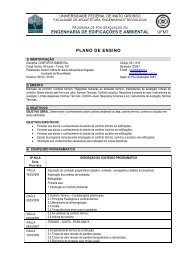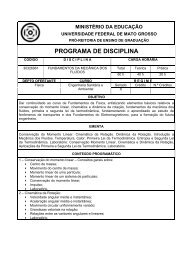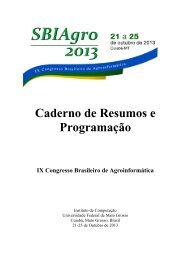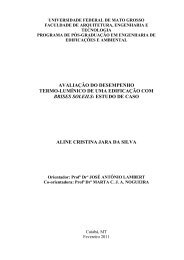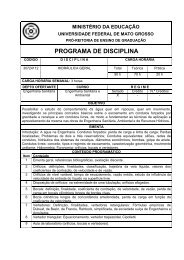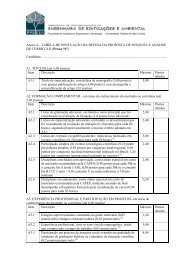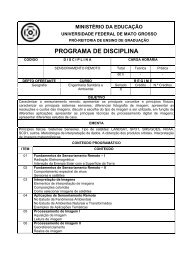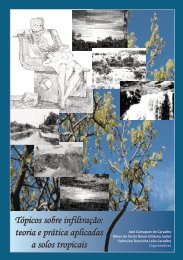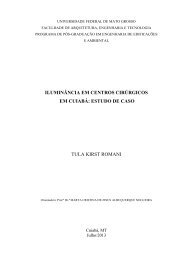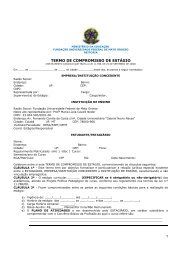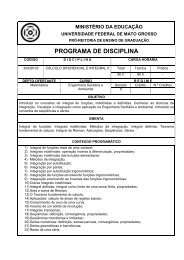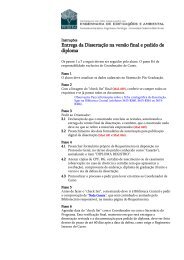Leaf area index of a tropical semi-deciduous forest of the southern ...
Leaf area index of a tropical semi-deciduous forest of the southern ...
Leaf area index of a tropical semi-deciduous forest of the southern ...
Create successful ePaper yourself
Turn your PDF publications into a flip-book with our unique Google optimized e-Paper software.
Int J Biometeorol (2011) 55:109–118DOI 10.1007/s00484-010-0317-1ORIGINAL PAPER<strong>Leaf</strong> <strong>area</strong> <strong>index</strong> <strong>of</strong> a <strong>tropical</strong> <strong>semi</strong>-<strong>deciduous</strong> <strong>forest</strong><strong>of</strong> <strong>the</strong> sou<strong>the</strong>rn Amazon BasinOsvaldo Borges Pinto-Júnior & Luciana Sanches &Francisco de Almeida Lobo &Adilson Amorim Brandão & José de Souza NogueiraReceived: 25 July 2009 /Revised: 7 April 2010 /Accepted: 7 April 2010 /Published online: 9 June 2010# ISB 2010Abstract <strong>Leaf</strong> <strong>area</strong> <strong>index</strong> (LAI) is an important ecophysiologicalvariable because leaves are <strong>the</strong> organs responsiblefor gas exchange between plants and <strong>the</strong> atmosphere. Thisvariable can be calculated from primary values <strong>of</strong> leaf <strong>area</strong>assessed by destructive or non-destructive methods, whichis relatively easy when crop species are investigated, but isnot <strong>the</strong> case when <strong>the</strong> focus is on natural wood plantscommunities. In this paper, we analyze <strong>the</strong> seasonality <strong>of</strong>LAI estimated by three different methods in <strong>the</strong> Amazoniasavannahtransitional <strong>forest</strong>, located 50 km north-east <strong>of</strong>Sinop city, Mato Grosso, Brazil. In <strong>the</strong> first method, wecombine Monsi and Saekis' original method [Monsi M,Saeki T (1953) Jpn J Bot 14:22–52], which measures LAIusing <strong>the</strong> Beer-Lambert extinction law, and <strong>the</strong> propositionO. B. Pinto-Júnior (*) : F. de Almeida Lobo : A. A. BrandãoDepartment <strong>of</strong> Soil and Rural Engineering,Federal University <strong>of</strong> Mato Grosso,Av. Fernando Correa da Costa s/n,Cuiabá, MT 78.060-900, Brazile-mail: osvaldo.borges@gmail.comF. de Almeida Loboe-mail: f_a_lobo@ufmt.brA. A. Brandãoe-mail: aabrandaojr@gmail.comL. SanchesDepartment <strong>of</strong> Sanitary and Environmental Engineering,Federal University <strong>of</strong> Mato Grosso,Av. Fernando Correa da Costa s/n,Cuiabá, MT 78.060-900, Brazile-mail: luciana.sanches@pq.cnpq.brJ. de Souza NogueiraDepartment <strong>of</strong> Physics, Federal University <strong>of</strong> Mato Grosso,Av. Fernando Correa da Costa s/n,Cuiabá, MT 78.060-900, Brazile-mail: nogueira@ufmt.br<strong>of</strong> Goudriaan [Goudriaan J (1988) Agric For Meteorol43:155–169] to estimate <strong>the</strong> extinction coefficient fromsolar height. The second method differed from <strong>the</strong> first onlyin <strong>the</strong> way in which <strong>the</strong> daily fraction <strong>of</strong> interceptedphotosyn<strong>the</strong>tic active radiation (FPAR) was calculated, asproposed by Charles-Edwards and Lawn (Charles-EdwardsDA, Lawn RJ (1984) Plant Cell Environ 7:247–251]. In <strong>the</strong>third method, we used a remote sensing technique[MOD15_BU-collection 4, produced and distributed byEROS Data Center Distributed Active Archive Center(EDC DAAC)]. We found that <strong>the</strong> first and <strong>the</strong> secondmethods revealed <strong>the</strong> expected LAI dynamics, whichincreased during <strong>the</strong> dry–wet transition and wet season,and decreased during <strong>the</strong> wet–dry transition and dry season.From 20 randomly distributed sets in a 1.0 ha <strong>area</strong>, only 3showed significant differences in LAI estimated from <strong>the</strong>first two methods; conversely, LAI was overestimated by<strong>the</strong> third method.Keywords Radiation interception . Photosyn<strong>the</strong>ticallyactive radiation . Extinction coefficientIntroductionOne <strong>of</strong> <strong>the</strong> most important characteristics <strong>of</strong> canopystructure is leaf <strong>area</strong> <strong>index</strong> (LAI), <strong>the</strong> total one-sidedfoliage <strong>area</strong> per unit soil surface <strong>area</strong>. LAI is critical for<strong>the</strong> estimation <strong>of</strong> a number <strong>of</strong> important ecosystemprocesses, including CO 2 flux, evapotranspiration, rainfallinterception, and litter deposition (Chason et al. 1991).There are two main types <strong>of</strong> procedure used to estimateLAI: direct and indirect methods. Direct methods consist <strong>of</strong>destructive or non-destructive field measurements assessing<strong>the</strong> leaves <strong>the</strong>mselves, while indirect methods derive LAI
110 Int J Biometeorol (2011) 55:109–118from models based on measured variables o<strong>the</strong>r than actualleaves. Both methods have <strong>the</strong>ir specific problems andlimitations. The decision <strong>of</strong> which method to use dependson many factors such as: <strong>the</strong> required accuracy, <strong>the</strong> timeavailable for performing measurements, <strong>the</strong> research scale,<strong>the</strong> available budget, etc. (Jonckheere et al. 2004), ando<strong>the</strong>r, site-specific restrictions, e.g., some methods are notsuitable for LAI estimates in <strong>tropical</strong> <strong>forest</strong>s (Wasseige etal. 2003).The use <strong>of</strong> micrometeorological towers with sensorsinstalled to measure radiation at different times and pointsis an effective method <strong>of</strong> estimating global or interceptedphotosyn<strong>the</strong>tically active radiation (PAR) captured by <strong>the</strong>canopy, which, according to Monsi and Saeki (1953), canbe used to estimate LAI in natural ecosystems, especially<strong>forest</strong>s. Based on <strong>the</strong> Beer-Lambert law <strong>of</strong> light extinction,<strong>the</strong>se sensors must be installed in representative locationswithin <strong>the</strong> environment, especially in dense <strong>forest</strong>s withheterogeneous vegetation.Sometimes, if a micrometeorological tower is notavailable, and where it is not possible to ga<strong>the</strong>r continuousradiation data, alternative methods must be used. Charles-Edwards and Lawn (1984) proposed an alternative methodthat made possible to estimate <strong>the</strong> daily fraction <strong>of</strong>intercepted radiation by <strong>the</strong> canopy using only an instantaneousmeasurement at midday. This method not onlyallowed <strong>the</strong> use <strong>of</strong> portable sensors and reduced <strong>the</strong> timerequired for taking measurements, but also allowed morethan a single point in <strong>the</strong> field to be used for LAIestimation, enhancing <strong>the</strong> accuracy <strong>of</strong> this estimate.Remote sensing techniques have been developed toestimate biophysical or biochemical attributes at <strong>the</strong>canopy or leaf color scale (Kodani et al. 2002). Moderateresolution imaging spectroradiometer (MODIS) is a sensoraboard <strong>the</strong> National Aeronautics and Space Administration(NASA) Terra satellite, which provides estimates <strong>of</strong>soil cover, and <strong>the</strong>se estimates can be used to calculateLAI, daily fraction <strong>of</strong> intercepted PAR (FPAR), grossprimary productivity (GPP) and net primary productivity(NPP), which makes it extremely convenient for use inconjunction with simulation models <strong>of</strong> ecosystems. Presently,<strong>the</strong> emphasis within <strong>the</strong> MODIS program is onvalidation <strong>of</strong> <strong>the</strong> algorithms and <strong>the</strong>ir products (Privette etal. 2002). The MODIS LAI algorithm is based on sixcanopy architectural types: grasses and cereal crops;shrubs; broadleaf crops; savannas; broadleaf <strong>forest</strong>s; andneedle leaf <strong>forest</strong>s (Myneni et al. 2002).In this paper, we compare different methods <strong>of</strong> estimatingLAI in a transitional <strong>tropical</strong> <strong>forest</strong> in <strong>the</strong> AmazonBasin, testing three <strong>of</strong> <strong>the</strong> methods most accessible to manyresearches working in natural ecosystems. The methodsevaluated were that <strong>of</strong> Monsi and Saeki (1953) with FPARobtained from continuous measurements <strong>of</strong> radiation,Monsi and Saeki (1953) with FPAR obtained by <strong>the</strong>method proposed by Charles-Edwards and Lawn (1984),and <strong>the</strong> remote sensing technique MOD15_BU-collection 4produced and distributed by EROS Data Center DistributedActive Archive Center (EDC DAAC).Material and methodsSite descriptionThe experiment was conducted in a transitional <strong>forest</strong>located 50 km NE <strong>of</strong> Sinop (11°24.75′S:55°19.50′W—coordinated from a micrometeorological tower in <strong>the</strong>transitional <strong>forest</strong>, Fig. 1), Mato Grosso, Brazil.The vegetation is composed <strong>of</strong> <strong>semi</strong> <strong>deciduous</strong> treespecies, such as Brosimum lactescens, Qualea paraensisand Tovomita schomburkii, with a maximum height <strong>of</strong>28 m (Sanches et al. 2008). The 30-year mean annualtemperature is 24°C with little seasonal variation, andrainfall is 2 m year −1 with a dry season between May andSeptember, and a wet season between October and April.The sites are located on <strong>the</strong> Araguaia formation, with <strong>the</strong>same soil texture (Oxisol soil; Marcelino et al. 2005). Thesoil near <strong>the</strong> <strong>forest</strong> tower site is a quartzarenic neosolcharacterized by sandy texture (84% sand, 4% silt, and12% clay in <strong>the</strong> upper 50 cm <strong>of</strong> soil; Priante-Filho et al.2004). The soils are quite sandy, poor in nutrients, <strong>the</strong>yhave high porosity and drain rapidly following rainfallevents (Vourlitis et al. 2002).Meteorological and ancillary measurementsA 40 m micrometeorological tower was installed in <strong>the</strong>study <strong>area</strong> equipped with different kind <strong>of</strong> sensorscontrolled by a datalogger (model CR 10X; CampbellScientific, Logan, UT) and recorded on a memory module(model SM16M; Campbell Scientific).PAR sensors (model LI-190; LI-COR Bioscience, Lincoln,NE) were installed at heights <strong>of</strong> 1, 20, and 40 m above <strong>the</strong>ground in <strong>the</strong> micrometeorological tower. These sensorsprovided all data employed to calculate LAI using <strong>the</strong> methodproposed by Monsi and Saeki (1953) withFPARobtainedfrom continuous measurements <strong>of</strong> radiation.To estimate LAI by <strong>the</strong> method proposed by Monsi andSaeki (1953) with FPAR obtained by <strong>the</strong> proposition <strong>of</strong>Charles-Edwards and Lawn (1984), 20 random sets werechosen in a 1.0 ha <strong>area</strong> (Fig. 2). At those set points,measurement <strong>of</strong> LAI below <strong>the</strong> canopy was performedusing a PAR sensor (model LI-190; LI-COR Bioscience)coupled to a datalogger (model CR10; Campbell Scientific)programmed to measure and record instantaneous PAR at arate <strong>of</strong> 1.0 s. For each set point, <strong>the</strong> average value <strong>of</strong> ten
Int J Biometeorol (2011) 55:109–118 111Fig. 1 Location <strong>of</strong> <strong>the</strong> <strong>area</strong>studied, approximately50 km N <strong>of</strong> Sinop city, MatoGrosso state, Brazil. The micrometeorologicaltower (graycircle) was located in a transitional<strong>forest</strong> at 11°24.75′S and55°19.50′Wmeasurements was taken as <strong>the</strong> instantaneous data. Thetime required to measure all 20 set points was from 11:00 a.m. to 1:00 p.m. (GMT−4). PAR measured above <strong>the</strong> canopywas taken from <strong>the</strong> micrometeorological tower.Air temperatures and relative humidities were taken40 m above <strong>the</strong> ground at <strong>the</strong> micrometeorologicaltower (12–14 m above <strong>the</strong> <strong>forest</strong> canopy) using ashielded relative humidity sensor (model HMP-35;Vaisala, Helsinki, Finland).Precipitation was measured every 30 min at <strong>the</strong> top <strong>of</strong><strong>the</strong> tower using a tipping-bucket rainfall gauge (model TE-525; Texas Electronics, Dallas, TX); however, gaps in datacollection precluded use <strong>of</strong> <strong>the</strong> rainfall data measured onsite, and data obtained from a manual rain gauge that wasread daily at <strong>the</strong> Fazenda Continental located 5 km E <strong>of</strong> <strong>the</strong>study site was used instead. Rainfall data collected by <strong>the</strong>manual rainfall gauge was highly correlated to datacollected on-site (Vourlitis et al. 2008).The atmospheric vapor pressure deficit (VPD) wascalculated as <strong>the</strong> difference between saturation vaporpressure and actual vapor pressure from temperature andhumidity measurements made at <strong>the</strong> top <strong>of</strong> <strong>the</strong> tower.Estimate <strong>of</strong> LAIEstimates <strong>of</strong> LAI using <strong>the</strong> Monsi and Saeki (1953)method with FPAR calculated from continuous PARrecord, or FPAR estimated by <strong>the</strong> proposition <strong>of</strong> Charles-Edwards and Lawn (1984) were calculated from August2007 to June 2008.Equation 1 was used to calculate FPAR from total dailycumulated PAR above and below <strong>the</strong> canopy, and Eq. 2was used when instantaneous data <strong>of</strong> PAR at noon wasrequired.ðFPAR ¼ PAR 40 PAR 40r Þ PAR 1ð1ÞðPAR 40 PAR 40r ÞWhere FPAR is <strong>the</strong> fraction <strong>of</strong> daily interceptedradiation, PAR 40 is <strong>the</strong> incident daily PAR on <strong>the</strong> top <strong>of</strong><strong>the</strong> canopy (mol m −2 day −1 ); PAR 40r is <strong>the</strong> daily PARreflected by <strong>the</strong> canopy (mol m −2 day −1 ); PAR 1 is <strong>the</strong> dailyPAR transmitted through <strong>the</strong> canopy (mol m −2 day −1 ).ð PAR 40rn Þ PAR 1nPAR 40rn Þð Þ PAR 1nðPAR 40n PAR 40rn ÞFPAR ¼ 2 PAR 40nðPAR 40n1 þ PAR 40n PAR 40rnð2ÞWhere FPAR is <strong>the</strong> fraction <strong>of</strong> daily interceptedradiation, PAR 40n is <strong>the</strong> incident instantaneous PAR atnoon on <strong>the</strong> top <strong>of</strong> <strong>the</strong> canopy (μmol m −2 s −1 ); PAR 40rn is<strong>the</strong> instantaneous PAR at noon reflected by <strong>the</strong> canopy(μmol m −2 s −1 ); PAR 1n is <strong>the</strong> instantaneous PAR at noontransmitted through <strong>the</strong> canopy (μmol m −2 s −1 ).The LAI was calculated by <strong>the</strong> fraction <strong>of</strong> dailyintercepted PAR, according to Eq. 3.LAI ¼ lnð1FPARÞð3ÞKWhere LAI is <strong>the</strong> leaf <strong>area</strong> <strong>index</strong> (m 2 m −2 ), FPAR is <strong>the</strong>fraction <strong>of</strong> daily intercepted radiation; K is <strong>the</strong> extinctioncoefficient <strong>of</strong> <strong>the</strong> canopy.
112 Int J Biometeorol (2011) 55:109–118Fig. 2 Location <strong>of</strong> 20 samplingpoints distributed randomly overa 1-ha <strong>area</strong> in <strong>the</strong> transitional<strong>forest</strong>The extinction coefficient (k) estimated is an estimateproposed by Goudriaan (1988), and considers <strong>the</strong> randomand circular distribution <strong>of</strong> <strong>the</strong> leaves in <strong>the</strong> canopy. Theinterception and extinction <strong>of</strong> light through <strong>the</strong> canopy canbe derived from <strong>the</strong> ratio between <strong>the</strong> average projection <strong>of</strong><strong>the</strong> leaves in <strong>the</strong> direction <strong>of</strong> <strong>the</strong> solar beam (O) and <strong>the</strong>elevation sun angle based on <strong>the</strong> horizon (Β) according toEq. 4.k ¼Oð4ÞsenBFor a distribution consisting <strong>of</strong> leaf angle, <strong>the</strong> averageprojection was determined based on <strong>the</strong> integration over <strong>the</strong>angle distribution <strong>of</strong> leaves (F) between zero and π/2,simplified according to Eq. 5.OðBÞ ¼F 1 O 1 ðBÞþF 2 O 2 ðBÞþF 3 O 3 ðBÞð5ÞWhere, F 1 , F 2 and F 3 are <strong>the</strong> relative distributionfrequencies <strong>of</strong> leaf inclination in classes <strong>of</strong> 15°, 45° and75°, respectively, each covering 30°, and <strong>of</strong> <strong>the</strong> sphericaldistribution, F 1 , F 2 and F 3 with values <strong>of</strong> 0.134, 0.366 and0.5, respectively. According to Goudriaan (1988) O 1 andO 2 are dependent on solar elevation angle; this approximatesto a combination <strong>of</strong> a sine wave and a constantlower limit, according to Eqs. 6 and 7.O 1 ¼ maxð0:26; 0:93senðBÞÞ ð6ÞO 2 ¼ maxð0:47; 0:68senðBÞÞ ð7ÞThe O 3 value is a reference projection for a sphericaldistribution, which regardless <strong>of</strong> <strong>the</strong> solar elevation, shouldbe equal to 0.5. Based on <strong>the</strong>se frequencies, <strong>the</strong> equation <strong>of</strong>O 3 was estimated according to Eq. 8.O 3 ¼ 1 0:268O 1 0:732O 2 ð8ÞThe solar elevation angle defined as <strong>the</strong> angle between<strong>the</strong> direction <strong>of</strong> <strong>the</strong> sun and <strong>the</strong> horizon (β) was determinateaccording to Eq. 9.B ¼ 90 Z ð9Þwhere, Z is <strong>the</strong> zenith angle, and Z depends on day time,place latitude and year time and was estimated according toEq. 10.cosZ ¼ senB ¼ sen8 sen dþ cos8 cosdcos½15ðt t 0 ÞŠ ð10Þwhere, 8 is <strong>the</strong> local latitude, δ is <strong>the</strong> solar declination, t is<strong>the</strong> time and t o is <strong>the</strong> sunset.The solar declination is calculated according to Eq. 11.sin d ¼ 0:39785 sin½278:97 þ 0:9856J þ 1:9165 sinð356:6 þ 0:9856JÞŠwhere, J is <strong>the</strong> Julian day.Estimate <strong>of</strong> LAI by remote sensingð11ÞLAI products from MODIS are produced with a spatialresolution <strong>of</strong> 1 km on a Sinusoidal grid. Values areprovided as a daily product (MOD15A1) and as a collatedmaximum value over a period <strong>of</strong> 8 days (MOD15A2), andas a monthly average product (MOD15_BU). The MODISLAI algorithm is based on three-dimensional radiativetransfer <strong>the</strong>ory and developed by inversion using a look-
Int J Biometeorol (2011) 55:109–118 113Fig. 3 Daily cycle for eachmonth <strong>of</strong> a incoming solar radiation(W m −2 ), b air temperature(°C), c relative humidity (%)and d vapor pressure deficit(VPD; kPa) from August 2007to July 2008
114 Int J Biometeorol (2011) 55:109–118Table 1 Average (±standard deviation) monthly global radiation, air temperature, relative humidity and vapor pressure deficit (VPD) from August2007 to July 2008Month/year Global radiation (W m −2 ) Air temperature (°C) Relative humidity (%) VPD (kPa)August/2007 570.0±386.4 24.0±6.0 59.1±21.6 1.4±1.3September/2007 460.9±315.9 25.3±5.4 64.5±21.1 1.3±1.3October/2007 479.6±329.1 25.3±3.8 40.8±2.9 0.37±0.32November/2007 487.4±298.0 24.6±3.1 79.7±12.6 0.62±0.62December/2007 453.7±259.5 24.2±2.5 82.8±10.6 0.47±0.47January/2008 529.4±272.5 23.5±2.3 85.6±8.8 0.42±0.41February/2008 475.5±283.2 23.6±2.4 85.4±9.3 0.32±0.3March/2008 439.6±265.1 23.8±2.6 85.3±10.11 0.11±0.26April/2008 425.2±286.2 24.3±2.8 84.2±11.5 0.4±0.5May/2008 419.3±283.5 23.9±3.6 79.4±14.4 0.6±0.4June/2008 499.1±348.5 23.6±5.0 71.4±20.7 1.0±1.1July/2008 535.1±374.0 24.1±5.6 60.4±20.7 1.4±1.3up table approach. The product used in this study isMOD15_BU-collection 4, produced and distributed to <strong>the</strong>public by <strong>the</strong> EROS Data Center Distributed ActiveArchive Center (EDC DAAC, available at http://daac.ornl.gov/cgi-bin/MODIS/GR_col5_1/mod_viz.html). The study<strong>area</strong> is located at coordinates −11.41S and −55.32W, whichincludes <strong>the</strong> micrometeorological tower. For each cell, <strong>the</strong>LAI value was analyzed and <strong>the</strong> quality assessed (QA),which determined <strong>the</strong> type <strong>of</strong> algorithm used or <strong>the</strong>inexistence <strong>of</strong> data. The monthly LAI was obtained by <strong>the</strong>arithmetic mean <strong>of</strong> four grid points, when data existedbased on five levels <strong>of</strong> <strong>the</strong> QA value for each cell. Toreduce noise and obtain a higher percentage <strong>of</strong> clear-skydata, MODIS products are distributed as maximum valuecomposites <strong>of</strong> 8-day ranges. Never<strong>the</strong>less, in <strong>the</strong> humid<strong>tropical</strong> regions, availability <strong>of</strong> high quality consistent timeseries remains low; in <strong>the</strong> case <strong>of</strong> our study site <strong>area</strong> (SinopMato Grosso, Brazil) only a part (∼50%) <strong>of</strong> <strong>the</strong> composites<strong>of</strong> <strong>the</strong> evaluated 1-year period have <strong>the</strong> highest QA level <strong>of</strong>0 and 1.Analysis methodMeteorology (global radiation, air temperature, humidityand VPD) were summarized as diurnal averages calculatedby averaging each 30-min datum for a particular time (e.g.,0900–0930 hours LT) over monthly intervals to obtain acomposite average trend in meteorology. This averagingprocess was conducted to allow <strong>the</strong> utilization <strong>of</strong> all datacollected and to provide an indication <strong>of</strong> how <strong>the</strong> LAI andmeteorology variables varied, on average, during <strong>the</strong>different hydrological periods.Assuming <strong>the</strong> dry season is <strong>the</strong> number <strong>of</strong> months withrainfall
Int J Biometeorol (2011) 55:109–118 115Table 3 Linear correlation matrix for average monthly incoming radiation, average monthly air temperature, average monthly relative humidity,average monthly VPD and leaf <strong>area</strong> <strong>index</strong> (LAI). Correlation coefficients were calculated over monthly intervals (n=12 months)Global radiation Air temperature Relative humidity VPD LAIGlobal Radiation 1Air temperature −0.182 1Relative humidity −0.408 −0.617* 1VPD 0.589* 0.176 −0.502 1LAI −0.097 0.364 0.090 −0.468 1*P
116 Int J Biometeorol (2011) 55:109–118Fig. 6 LAI estimated by <strong>the</strong>Lambert-Beer method (blackcircles) and by product MODIS(white circles) ina 2007 and b2008between air temperature and relative humidity, and betweenair temperature and VPD.Seasonality <strong>of</strong> LAIThe LAI estimated by <strong>the</strong> micrometeorological data fromAugust 2007 to June 2008 resulted in a maximum value in<strong>the</strong> wet season (4.25 m 2 m −2 ) and a minimum value in <strong>the</strong>dry season (3.32 m 2 m −2 ; Fig. 4). LAI was higher in <strong>the</strong> wetand dry–wet seasons due to an increase in <strong>forest</strong> vegetationgrowth as a consequence <strong>of</strong> increased water availability.Fur<strong>the</strong>rmore, during <strong>the</strong> wet season <strong>the</strong>re was a higherglobal radiation (Table 1). Light is essential for photosyn<strong>the</strong>sisand o<strong>the</strong>r plant processes, and consequently plays animportant role in driving growth (King et al. 2005).The behavior pattern <strong>of</strong> <strong>the</strong> vertical pr<strong>of</strong>ile <strong>of</strong> <strong>the</strong> LAIdemonstrated reduced values in <strong>the</strong> lower stratum. Onaverage, in <strong>the</strong> upper stratum, <strong>the</strong> LAI was 20% higher (a<strong>the</strong>ight 40 m; Fig. 5) due to <strong>the</strong> foliage density at a canopyheight <strong>of</strong> 28–40 m.Ano<strong>the</strong>r reflectance <strong>index</strong> that is commonly related t<strong>of</strong>orest LAI is <strong>the</strong> LAI product MODIS. Satellite-derivedestimates <strong>of</strong> MODIS have been used extensively to observe<strong>the</strong> green-up and brown-up <strong>of</strong> terrestrial ecosystems and tomap LAI in time and space. Figure 6 shows <strong>the</strong> relationshipbetween estimated LAI and LAI product MODIS. Figure 7shows <strong>the</strong> estimated LAI and LAI product MODIS in a boxplot figure.Average estimated LAI using <strong>the</strong> product MODIS was3.4 m 2 m −2 from January to May. The months with <strong>the</strong> mostreliable data were June and July—a period with lesscloudiness and also high radiation. The months with lessreliable data were January, February, March and April—months with higher rainfall rates, when estimates wereinfluenced by cloudiness. There was no significant correlationbetween estimates using different methods. Using <strong>the</strong>product MODIS, <strong>the</strong> mean LAI values identified in <strong>forest</strong><strong>area</strong>s were low, which could be due to clouds, which arenot filtered by <strong>the</strong> algorithm, generating low LAI valuesdue to high reflectance, consequently reducing <strong>the</strong> meanLAI. The lower values compared with LAI estimated by <strong>the</strong>Lambert-Beer method were likely due to influences such asnoise effects (atmospheric path radiances), <strong>the</strong> exhibition <strong>of</strong>asymptotic (saturated) signals over high biomass condi-Fig. 7 LAI estimated by <strong>the</strong>Lambert-Beer method and productMODIS displayed as a boxplot figure in a 2007 and b2008. Dotted line Mean, solidline median
Int J Biometeorol (2011) 55:109–118 117Table 4 Paired t-test <strong>of</strong> average <strong>of</strong> LAI obtained by <strong>the</strong> Monsi andSaeki method (at <strong>the</strong> point <strong>of</strong> <strong>the</strong> tower) and Charles-Edwards andLawn method (on 20 sampling points). A t-test was used to analyze<strong>the</strong> relationship between <strong>the</strong> tower and <strong>the</strong> spatial variation on 20sampling points (t-test, t=2.30). P is <strong>the</strong> interval confidenceLAI average at <strong>the</strong>tower (Monsi andSaeki method)SamplingpointsAverage LAI over 20sampling points(Charles-Edwards andLawn method)PFig. 8 Correlation between LAI calculated from radiation measures at<strong>the</strong> 20 sampling points (Charles-Edwards and Lawn method) withthose calculated from <strong>the</strong> radiation data taken from <strong>the</strong> micrometeorologicaltower (Monsi and Saeki method). Dotted line 1:1tions, and <strong>the</strong> sensitivity <strong>of</strong> this method to canopybackground variations (Aragão et al. 2005). The interfacebetween ecosystems and <strong>the</strong> atmosphere is very difficult toquantify due to spatial variability (vertical and horizontal)and temporal variability: annual cycles and inter-yearvariation interact with structural patterns, stratification andhomogeneity (Bréda 2003). Factors such as <strong>the</strong> differencesin absorption should be considered. While <strong>the</strong> MODISalgorithm determines LAI from <strong>the</strong> absorption <strong>of</strong> radiationby leaves only, LAI estimated from micrometeorologicaldata takes into account PAR absorbed by leaves (Senna andCosta 2005).The higher spatial resolution <strong>of</strong> <strong>the</strong> MODIS data mayenable more accurate derivation <strong>of</strong> surface longwaveradiation because it provides more detailed informationabout <strong>the</strong> atmosphere and land surface than sensors with acoarser spatial resolution (Wang and Liang 2008). Due to<strong>the</strong> high resolution (down to 1 km), land surface modelsusing MODIS data have been applied to natural ecosystems;however, <strong>the</strong> spatial resolution that specifies <strong>the</strong> pixelsize <strong>of</strong> satellite images covering <strong>the</strong> Earth’s surface for <strong>the</strong>LAI data MODIS algorithm determines LAI at 1 km spatialresolution, and in this paper LAI estimated by fieldobservation was determined at a single point <strong>of</strong> observation.Thus, <strong>the</strong> monthly LAI was obtained by <strong>the</strong> arithmeticmean <strong>of</strong> four grid points in <strong>the</strong> transitional <strong>forest</strong> to reduce<strong>the</strong> possible influence <strong>of</strong> spatial resolution <strong>of</strong> MODISproducts.The LAI estimated by <strong>the</strong> Lambert-Beer method resultedin an asymmetric distribution skewed towards <strong>the</strong> right(Fig. 8). The distance from <strong>the</strong> third quartile to <strong>the</strong> medianis more than <strong>the</strong> distance from <strong>the</strong> medium to <strong>the</strong> firstquartile, suggesting that 75% <strong>of</strong> <strong>the</strong> LAI estimates liebetween <strong>the</strong> third quartile and <strong>the</strong> upper limit. The LAIestimated by MODIS product resulted in an asymmetric4.2 Point 1 4.5 0.704.2 Point 2 4.4 0.844.2 Point 3 4.0 0.794.2 Point 4 4.6 0.414.2 Point 5 4.9 0.244.2 Point 6 4.5 0.574.2 Point 7 4.3 0.884.2 Point 8 4.6 0.354.2 Point 9 4.5 0.594.2 Point 10 5.4 0.04*4.2 Point 11 5.0 0.05*4.2 Point 12 5.2 0.05*4.2 Point 13 5.1 0.02*4.2 Point 14 4.9 0.03*4.2 Point 15 4.9 0.174.2 Point 16 4.4 0.674.2 Point 17 4.1 0.904.2 Point 18 4.7 0.084.2 Point 19 3.8 0.324.2 Point 20 4.2 0.93*P0.05).Spatial variation <strong>of</strong> LAIA t-test (P>0.05) was used to analyze <strong>the</strong> relationshipbetween <strong>the</strong> tower point and spatial variation based on 20sampling points distributed randomly in a 1-ha <strong>area</strong>(Table 4). During December 2007, <strong>the</strong>re was a higherspatial LAI variability X I:C: 95% ¼ 5:1 0:6m 2 m 2probably due to marked horizontal variations in radiationavailability—<strong>of</strong>ten only 1–2% <strong>of</strong> full sunlight penetrated to<strong>the</strong> understory.
118 Int J Biometeorol (2011) 55:109–118There were significant differences between LAI estimatedby <strong>the</strong> Monsi and Saeki method taken from <strong>the</strong> towerpoint and LAI taken from <strong>the</strong> 20 sampling points,especially at points 10, 11, 13 and 14.Uncertainty related to <strong>the</strong> LAI estimate at <strong>the</strong> canopylevel must be noted. LAI could be underestimated if solarradiation passed through <strong>the</strong> canopy and focused directlyon <strong>the</strong> sensor installed below <strong>the</strong> canopy. It would <strong>the</strong>nprovide an estimate fraction with minimal values or zeroand this would lead to smaller LAI estimates. Alternatively,LAI could be overestimated if <strong>the</strong>re was a physicalimpediment o<strong>the</strong>r than leaves. This would lead to overestimates<strong>of</strong> <strong>the</strong> fraction intercepted.ConclusionsLAI estimated from randomly distributed sampling pointsin a 1-ha <strong>area</strong> was significantly correlated in 17/20 pointswith LAI estimated at <strong>the</strong> tower point.The above correlation notwithstanding, <strong>the</strong> LAI productfrom MODIS is important for monitoring and modelingglobal change and terrestrial dynamics at many scales.However, cloud contamination effects on MODIS LAIproduct need to be taken into account carefully beforeanalyzing LAI patterns. The effect <strong>of</strong> cloudiness can lead toerroneous interpretation <strong>of</strong> <strong>the</strong> results. In this study, LAIestimated using <strong>the</strong> MODIS product underestimated <strong>the</strong>values. The correlation between LAI estimated using <strong>the</strong>MODIS product and <strong>the</strong> Lambert-Beer method resulted insignificant differences.Acknowledgments This research was supported in part by UniversidadeFederal de Mato Grosso (UFMT), Conselho Nacional deDesenvolvimento Científico e Tecnológico (CNPq), and <strong>the</strong> Coordenaçãode Aperfeiçoamento de Pessoal de Nivel Superior (CAPES).ReferencesAragão LEOC, Shimabukuro YE, Espírito-Santo FDB, Williams M(2005) Spatial validation <strong>of</strong> <strong>the</strong> collection 4 MODIS LAI productin Eastern Amazonia. IEEE Trans Geosci Remote Sens 43(11):2526–2534Bréda NJJ (2003) Ground-based measurements <strong>of</strong> leaf <strong>area</strong> <strong>index</strong>: areview <strong>of</strong> methods, instruments and current controversies. J ExpBot 54:2403–2417Charles-Edwards DA, Lawn RJ (1984) Light interception by grainlegume row crops. Plant Cell Environ 7:247–251Chason JW, Baldocchi DD, Huston MA (1991) A comparison <strong>of</strong>direct and indirect methods for estimating <strong>forest</strong> canopy leaf <strong>area</strong>.Agric For Meteorol 57:107–128Goudriaan J (1988) The bare bones <strong>of</strong> leaf-angle distribution inradiation models for canopy photosyn<strong>the</strong>sis and energy exchange.Agric For Meteorol 43:155–169Jonckheere I, Fleck S, Nackaerts K, Muysa B, Coppin P, Weiss M,Baret F (2004) Review <strong>of</strong> methods for in situ leaf <strong>area</strong> <strong>index</strong>determination part I. Theories, sensors and hemisphericalphotography. Agric For Meteorol 121:19–35. doi:10.1016/j.agrformet.2003.08.027King DA, Davies SJ, Supardi MNN, Tan S (2005) Tree growth isrelated to light interception and wood density in two mixeddipterocarp <strong>forest</strong>s <strong>of</strong> Malaysia. Funct Ecol 19:445–453Kodani E, Awaya Y, Tanaka K, Matsumura N (2002) Seasonalpatterns <strong>of</strong> canopy structure, biochemistry and spectral reflectancein a broad-leaved <strong>deciduous</strong> Fagus crenata canopy. ForEcol Manage 167:233–249Marcelino T, Shirawa S, Borges WR, Priante-Filho N, Raiter F (2005)GPR para verificação do nível d’água subterrânea em transiçãoFloresta Amazônica e Cerrado. Acta Amazonica 35:369–376Monsi M, Saeki T (1953) Über den Lichtfakor in den Pflanzengesellschaften,seine Bedeutung für die St<strong>of</strong>fproduckion. Jpn J Bot14:22–52Myneni RB, H<strong>of</strong>fman S, Knyazikhin Y, Privette JL, Glassy J, TianY,WangY,SongS,ZhangY,SmithGR,LotschA,FrieldM,Morrisette JT, Votava P, Nemani RR, Running SW (2002)Global products <strong>of</strong> vegetation leaf <strong>area</strong> and fraction absorbedPAR from year one <strong>of</strong> MODIS data. Remote Sens Environ83:214–231Priante-Filho N, Vourtilis GL, Hayashi MMS, Nogueira JS, Campelo-Junior JH, Nunes PC, Sanches L, Couto EG, Hoeger W, Raiter F,Trienweiler JL, Miranda EJ, Priante PC, Fritzen CL, Lacerda M,Pereira LC, Biudes MS, Suli GS, Shiraiwa S, Paulo SR, SilveiraM (2004) Comparison <strong>of</strong> <strong>the</strong> mass and energy exchange <strong>of</strong> apasture and a mature transitional <strong>tropical</strong> <strong>forest</strong> <strong>of</strong> <strong>the</strong> sou<strong>the</strong>rnAmazon Basin during a seasonal transition. Glob Chang Biol10:863–876Privette JL, Myneni RB, Knyazikhin Y, Mukufute M, Roberts G, TianY, Wang Y, Leblanc SG (2002) Early spatial and temporalvalidation <strong>of</strong> MODIS LAI product in Africa. Remote SensEnviron 83:232–243Sanches L, Valentini CMA, Pinto-Júnior OB, Nogueira JS, VourlitisGL, Biudes MS, Silva CJ, Bambi P, Lobo FA (2008) Seasonaland interannual litter dynamics <strong>of</strong> a <strong>tropical</strong> <strong>semi</strong><strong>deciduous</strong> <strong>forest</strong><strong>of</strong> <strong>the</strong> sou<strong>the</strong>rn Amazon Basin, Brazil. J Geophys Res 113(2008):G04007. doi:10.1029/2007JG000593Senna MCA, Costa MH (2005) Fraction <strong>of</strong> photosyn<strong>the</strong>tically activeradiation absorbed by Amazon <strong>tropical</strong> <strong>forest</strong>: a comparison <strong>of</strong>field measurements, modeling, and remote sensing. J GeophysRes 110:G01008. doi:10.1029/2004JG000005Shuttleworth WJ, Gash JHC, Lloyd CR et al (1988) Eddy correlationmeasurements <strong>of</strong> energy partitioning for Amazonian <strong>forest</strong>. Q J RMeteorol Soc 110:1143–1162Vourtilis GL, Priante-Filho N, Hayashi MMS, Nogueira JS, Caseiro F,Campelo-Júnior JH (2002) Seasonal variations in <strong>the</strong> evapotranspiration<strong>of</strong> a transitional <strong>tropical</strong> Forest <strong>of</strong> Mato Grosso, Brazil.Water Resour Res 38. doi:10.1029/2000WR000122Vourlitis GL, Nogueira JS, Lobo FA, Sendall KM, Faria JLB, DiasCAA, Andrade NLR (2008) Energy balance and canopyconductance <strong>of</strong> a <strong>tropical</strong> <strong>semi</strong>-<strong>deciduous</strong> <strong>forest</strong> <strong>of</strong> <strong>the</strong> sou<strong>the</strong>rnAmazon Basin. Water Resour Res 44:W03412. doi:10.1029/2006WR005526Wang W, Liang S (2008) Estimation <strong>of</strong> high-spatial resolution clearskylongwave downward and net radiation over land surfacesfrom MODIS data. Remote Sens Environ 113(4):745–754.doi:10.1016/j.rse.2008.12.004Wasseige C, Bastin D, Defourny P (2003) Seasonal variation <strong>of</strong><strong>tropical</strong> <strong>forest</strong> LAI based on field measurements in CentralAfrican Republic. Agric For Meteorol 119:181–194



